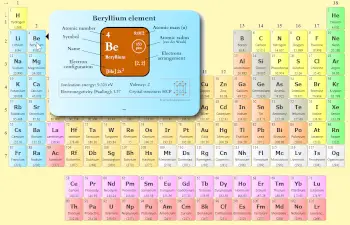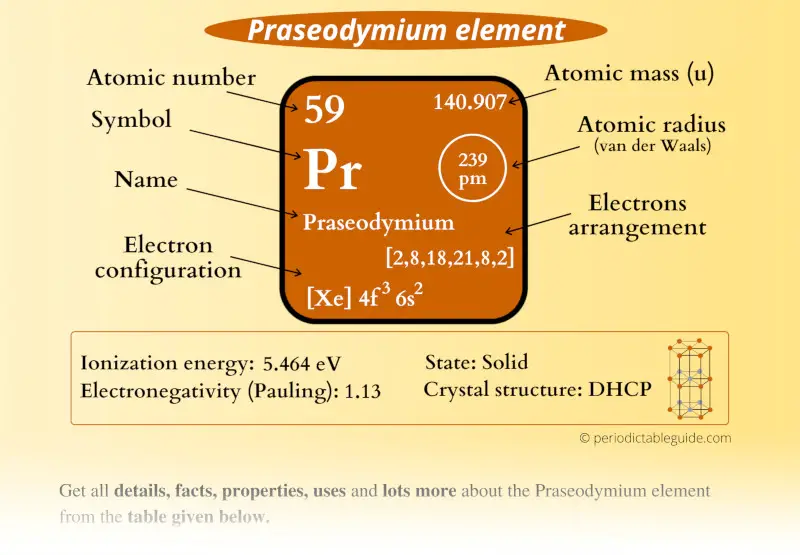
This is a SUPER easy guide on Praseodymium element.
In fact, the table mentioned below is the perfect information box (Which gives you every single detail about the Praseodymium element in Periodic table.)
So if you want to know anything about Praseodymium element, then this guide is for you.
Let’s finish this very quickly.
Praseodymium Element (Pr) Information
| Appearance | 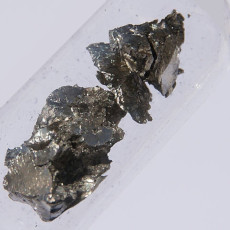 Gray white metallic |
| State (at STP) | Solid |
| Position in Periodic table | 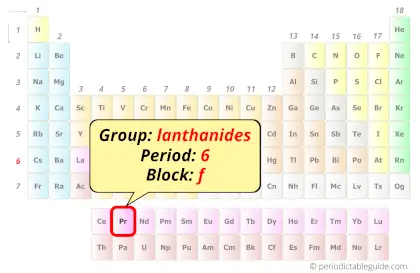 Group: lanthanides, Period: 6, Block: f |
| Category | 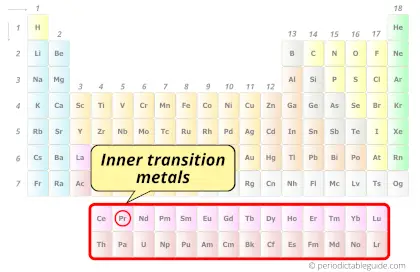 Inner transition metals |
| Atomic number or Protons | 59 |
| Neutrons | 82 |
| Electrons | 59 |
| Symbol | Pr |
| Atomic mass | 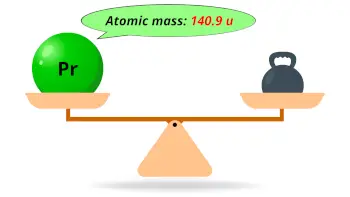 140.907 u |
| Electrons arrangement or Bohr model | 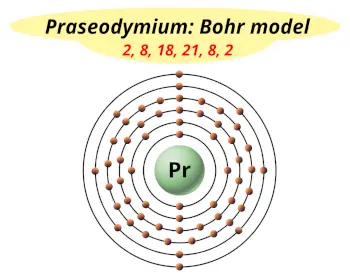 2, 8, 18, 21, 8, 2 |
| Electronic configuration | [Xe] 4f3 6s2 |
| Atomic radius | 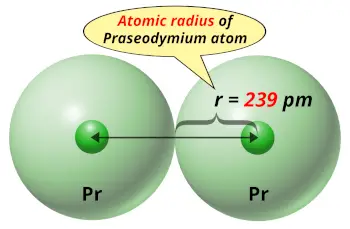 239 picometers (van der Waals radius) |
| 1st Ionization energy | 5.464 eV |
| Electronegativity | 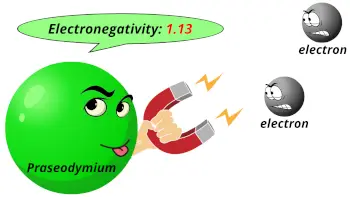 1.13 (Pauling scale) |
| Crystal structure | 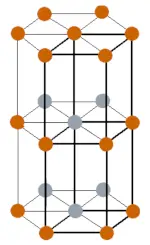 Double hexagonal close packed |
| Melting point | 1208 K or 935 °C or 1715 °F |
| Boiling point | 3403 K or 3130 °C or 5666 °F |
| Density | 6.64 g/cm3 |
| Main isotope | 141Pr |
| Who discovered Praseodymium and when? |  Carl Auer von Welsbach in 1885 |
| CAS number | 7440-10-0 |
Praseodymium in Periodic table
Praseodymium element is in period 6 and in lanthanide group of the Periodic table. Praseodymium is the f-block element and it belongs to inner transition metals group.
| H | He | ||||||||||||||||
| Li | Be | B | C | N | O | F | Ne | ||||||||||
| Na | Mg | Al | Si | P | S | Cl | Ar | ||||||||||
| K | Ca | Sc | Ti | V | Cr | Mn | Fe | Co | Ni | Cu | Zn | Ga | Ge | As | Se | Br | Kr |
| Rb | Sr | Y | Zr | Nb | Mo | Tc | Ru | Rh | Pd | Ag | Cd | In | Sn | Sb | Te | I | Xe |
| Cs | Ba | La* | Hf | Ta | W | Re | Os | Ir | Pt | Au | Hg | Tl | Pb | Bi | Po | At | Rn |
| Fr | Ra | Ac** | Rf | Db | Sg | Bh | Hs | Mt | Ds | Rg | Cn | Nh | Fl | Mc | Lv | Ts | Og |
| *Ce | Pr | Nd | Pm | Sm | Eu | Gd | Tb | Dy | Ho | Er | Tm | Yb | Lu | ||||
| **Th | Pa | U | Np | Pu | Am | Cm | Bk | Cf | Es | Fm | Md | No | Lr |
←Move to: Cerium (Ce) element – Periodic Table
→Move to: Neodymium (Nd) element – Periodic Table
Why is Praseodymium in Period 6?
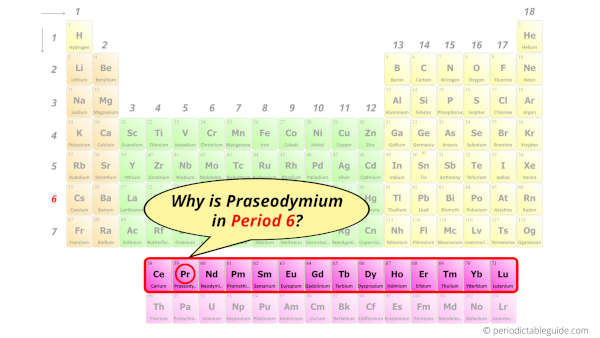
Let me ask you a question.
How many shells does praseodymium have?
It’s 6. Right?
You have already seen the bohr model of praseodymium atom in the above table.
From the Bohr model, it can be found that the number of orbits or shells in praseodymium is 6. Hence, as praseodymium has 6 orbits, it lies in period 6 of the Periodic table.
Why is Praseodymium in f-block?
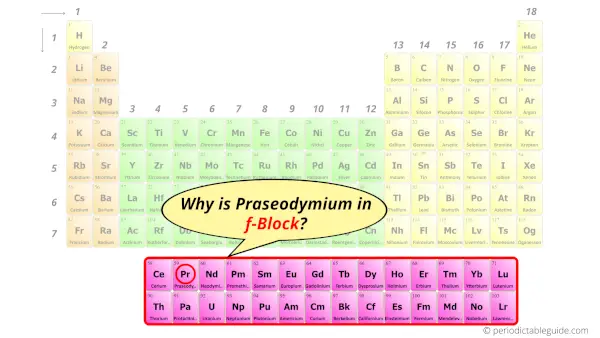
Before knowing this reason, first of all I want to ask you a simple question.
How can you determine the blocks-wise position of elements?
The simple answer: The elements will lie in the s, p, d or f block will completely depend upon the subshell in which the last electron will enter.
For example; the electron configuration of praseodymium is [Xe] 6s2 4f3.
So the last electron of praseodymium enters the f-subshell or f-orbital.
Hence, praseodymium is the f-block element.
5 Interesting facts about Praseodymium
Interesting facts about praseodymium element are mentioned below.
- The name praseodymium was derived from the two Greek words “prasios” and “didymos”. Prasios means green, and didymos means twin.
- Praseodymium was discovered by Carl Auer von Welsbach in 1885.
- The concentration of praseodymium in the earth’s crust is approximately 8.7 parts per million by weight.
- Praseodymium is a rare earth metal, but it is not actually rare in quantity. The fact is that it is spread evenly on the earth and it is very difficult to find this element at one place on the earth. Thus it is rare in the context of available resources.
- The yellow colored glass can be obtained by using praseodymium metal in glass manufacturing.
Properties of Praseodymium
The physical and chemical properties of praseodymium element are mentioned below.
Physical properties of Praseodymium
Physical properties of praseodymium are mentioned below.
- Praseodymium is a soft metal that has a grey white metallic appearance.
- This metal is ductile as well as malleable.
- The melting point of praseodymium is 935 °C and its boiling point is 3130 °C.
- The atomic mass of praseodymium is 140.907 u and its density is 6.64 g/cm3.
- The crystal structure of praseodymium is Double hexagonal close packed.
- Praseodymium has many isotopes, but out of those isotopes 141Pr is most abundant (almost 100%). Rest of the isotopes are artificially prepared in the laboratory by humans.
Chemical properties of Praseodymium
Chemical properties of praseodymium are mentioned below.
- Praseodymium is a chemically reactive metal and hence it is not found in its free state. It is always found as a compound with other elements in the earth’s crust.
- When praseodymium is kept open in air, it reacts with oxygen and forms a green oxide layer on it.
- Because of the reactivity of praseodymium with air, it is always stored in a kerosene or some other protective atmosphere.
- The common oxidation state of praseodymium is +3. But it also shows other oxidation states such as +2, +4 and +5.
- The last electron in praseodymium enters the f-orbital and hence it is classified as a f-block element on the periodic table.
- The first ionization energy of praseodymium is 5.464 eV.
- The electronegativity of praseodymium is 1.13 on the Pauling scale.
Uses of Praseodymium
Uses of praseodymium are mentioned below.
- Praseodymium is used as an alloying element with magnesium which results in a stronger metal that is used in engines of aircraft.
- Cigarette lighters use an alloy that contains praseodymium in it.
- Praseodymium is also used in carbon arc lighting that is used in projector lights.
- Praseodymium is also used as a doping agent in fiber optic cables which is used to amplify the signals.
Free Gift for you: Interactive Periodic Table
Let me tell you how this Interactive Periodic Table will help you in your studies.
1). You can effortlessly find every single detail about the elements from this single Interactive Periodic table.
2). You will get the detailed information about the periodic table which will convert a newbie into pro.
3). You will also get the HD images of the Periodic table (for FREE).
Checkout Interactive Periodic table and download it’s high resolution image now (It’s FREE)
External resources:
- Praseodymium – Element information, properties and uses | Periodic Table. (n.d.). Praseodymium – Element Information, Properties and Uses | Periodic Table. https://www.rsc.org/periodic-table/element/59/praseodymium
- Praseodymium – Wikipedia. (2009, August 8). Praseodymium – Wikipedia. https://en.wikipedia.org/wiki/Praseodymium
- It’s Elemental – The Element Praseodymium. (n.d.). It’s Elemental – the Element Praseodymium. https://education.jlab.org/itselemental/ele059.html
- P. (n.d.). Praseodymium | Pr (Element) – PubChem. Praseodymium | Pr (Element) – PubChem. https://pubchem.ncbi.nlm.nih.gov/element/Praseodymium
- Atomic Data for Praseodymium (Pr). (n.d.). Atomic Data for Praseodymium (Pr). https://physics.nist.gov/PhysRefData/Handbook/Tables/praseodymiumtable1.htm
